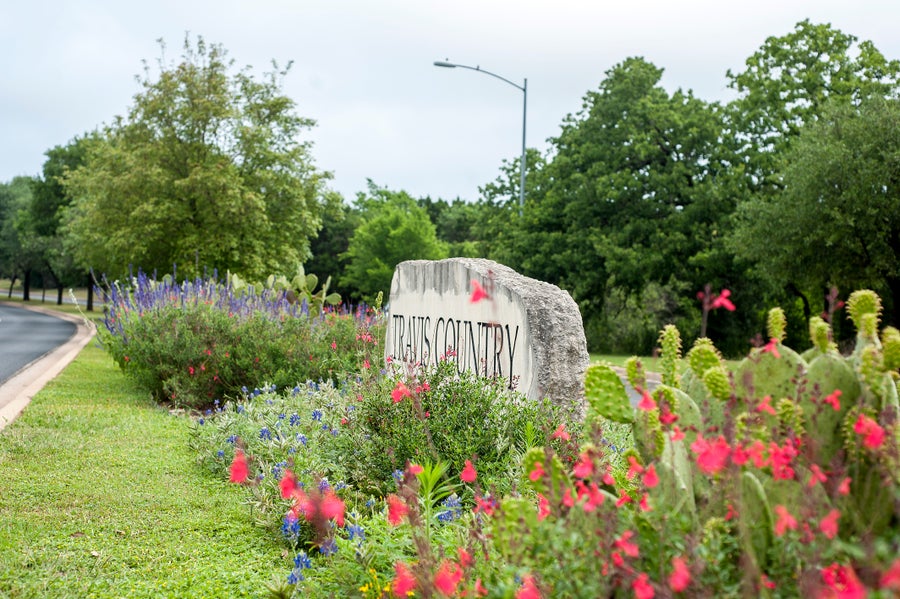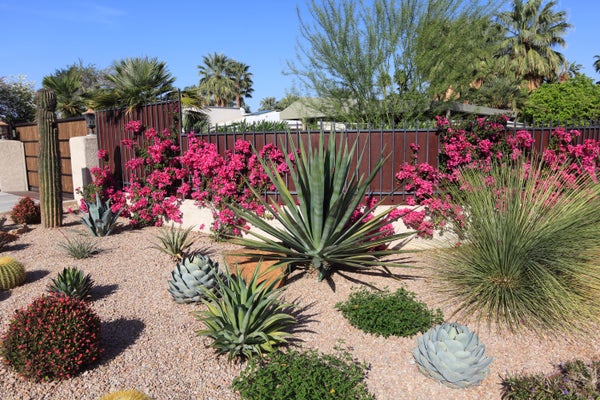Yards in Austin, Tex., look like most across the country: sprawling expanses of short, uniform grass. But when intense Texas droughts set in, dead brown patches deface the Kelly green monochrome. Instead of repeatedly replanting these patches with the typical sod, the homeowner association of one Austin neighborhood, Travis Country, offers another option: filling in the brown spots with less-thirsty native species. As Cynthia Wilcox, the association’s grounds committee chair, puts it: “When your grass gets big dead spots, stop fighting it.” About 750 homeowners—half of the subdivision—have taken this advice. Roughly 500 of those homes have gone even further, landscaping much of their property with drought-tolerant native species such as long-bladed buffalo grass, slender salvia stalks and mountain laurel trees, which drip with purple blossoms that some people think smell like grape soda.
With homeowner associations often focused on projecting a uniform, ideal suburban image, it is rare for one to suggest—let alone allow—such a landscape shift. But precisely because these groups (usually called HOAs) establish and enforce aesthetic rules for millions of American yards, they could be a way to spread sustainable practices promoted by conservationists—while also helping subdivisions tackle problems ranging from unsightly lawn splotches to polluting fertilizer runoff. Some conservation programs are testing ways to overcome sociological and economic hurdles to get HOAs to embrace such changes, or at least not oppose them.
Residential lawns in the U.S. suck up a lot of water. EPA data show that, on average, 15 percent of residential water use involves lawns—which cover three times more land than crops irrigated for agriculture, according to NOAA and NASA research. Furthermore, grass fertilizer can run off into nearby streams, ponds or other water bodies, sometimes fueling algae blooms. And using homogenous flora such as commercial lawn grass species across many geographic zones dilutes local biodiversity; the practice has been linked to at least one native species decline, as introduced plants replace the native vegetation to which local wildlife has long adapted.
On supporting science journalism
If you're enjoying this article, consider supporting our award-winning journalism by subscribing. By purchasing a subscription you are helping to ensure the future of impactful stories about the discoveries and ideas shaping our world today.
Conservationists have argued that some of these problems could be avoided if people made more diverse landscaping choices that support native species. In arid parts of the West, for example, landscaping a yard with local, drought-tolerant species and opting for mulch over grass can cut household water use by 30 percent. Native turfgrasses (which can replace typical lawn grass species) sprout fewer weeds and grow more slowly, reducing the need for mowing and its associated carbon emissions. Susannah Lerman, an ecologist with the U.S. Forest Service, also found that lawns mowed less frequently supported more bees.

Travis Country, a neighborhood in Austin, Texas, has encouraged residents to plant drought-tolerant native species in their yards. Credit: Laura Hajar
These changes can be hard sells for some residents, though, sometimes because they belong to homeowner associations with strict rules on yard appearance. HOAs are usually run by a handful of elected residents of a subdivision or neighborhood, but long-standing rules—such as grass being kept below a certain height—can come to be at odds with residents’ changing desires. In new subdivisions HOA rules may actually be established by developers, not the residents who ultimately move in. And sometimes, residents within an HOA are surprised by how strict landscaping rules are, or may disagree on yard upkeep standards. HOAs can fine people found in violation of rules, and conflicts over lawn care sometimes escalate to lawsuits. About 80 percent of new U.S. subdivision residents belong to an HOA, according to a July 2019 study in the Journal of Urban Economics.
“It is a little alarming for those of us who work in landscapes and sustainability to know that HOAs have a lot of influence and power over how a lot of our urban areas look,” says Gail Hansen, a professor of environmental horticulture at the University of Florida. But she and others are trying to turn that dynamic of enforced uniformity into an advantage by prodding HOAs to broaden their definition of what an acceptable yard looks like, in order to boost native-friendly landscaping across a community rather than rely on piecemeal efforts by environmentally minded homeowners. Sometimes that includes creating government programs, enacting state or local laws—or simply speaking with HOAs and residents themselves.
For over 30 years, a state government program has encouraged Florida residents to switch to sustainable landscapes with plants that are pest-resistant, drought-tolerant and thrive in most conditions, Hansen says. In northern Florida that could include the silvery pineapple guava shrub, while in the south an evergreen called natal plum can be kept trimmed low serve as groundcover. State law dictates that HOAs cannot prevent residents from planting these “Florida-Friendly” options. However, HOAs can still push back if homeowners choose plants or designs that do not meet neighborhood aesthetic standards. Hansen speaks with residents about how the initiative can work within HOA rules, and she also sometimes persuades board members to rewrite their mandates to accommodate the program. There are about 500 yards certified with the program, with still more properties practicing at least some of the recommended conservation measures. Last year a majority of the more than 220,000 attendees of water conservation workshops taught by University of Florida extension faculty reported scaling back their lawn watering afterwards.
A nascent state government program in Minnesota—which will offer funds for residents who plant flowers and legume species that support native insects—hopes to find HOAs that could become demonstration neighborhoods, where multiple homes would replant to boost overall interest in the project. In Texas, meanwhile, sustainable lawns have been a contentious topic. A few other subdivisions there have joined Travis Country in promoting them—but the state legislature had to pass a law prohibiting other HOAs from banning low-irrigation landscapes.
Scientists have worked to understand some of the strong social pressures that led HOAs and some of their residents to desire lawn uniformity in the first place, in order to harness those pressures in a more sustainable direction. Some of the reluctance Hansen runs into has to do with the notion that “sustainable” lawns look disorderly. In surveys of residents in Detroit and other U.S. cities, Joan Nassauer, a University of Michigan professor who investigates ecological design, found that 80 percent of respondents—no matter what yard style they preferred—said they wanted it to be neat. “When you introduce something new in a neighborhood that has ecological benefits, it can never look messy by neighborhood standards,” she says. To show that eco-friendly lawns can be tidy, Hansen punctuates her presentations with photos of well-maintained examples. Where changes like mowing a yard less often might make yards a little scruffier, printable yard signs provided by the U.S. Forest Service can help explain to neighbors that the lawn’s appearance has a larger purpose.
Nassauer’s research also shows that residents want their yards to fit in with those of their neighbors, so environmentally friendly aesthetics might be easier to pull off if the entire neighborhood adopts the practices instead of a few individual homes. When residents and their HOAS are both reluctant to push boundaries, Hansen also shows ways to make sustainable landscaping blend in—such as keeping a strip of grass to give the illusion of a yard.
Then there is the ultimate concern of any homeowner: property value. HOAs and homeowners see traditional lawns as a safe bet that sells, Hansen notes. New approaches are more likely to appeal to residents if the changes explicitly help property values, says Matthew Freedman, an economist at the University of California, Irvine, who has studied how HOAs impact housing prices and neighborhood conformity. “We don’t see a lot of HOAs encouraging activities that will have benefits that extend beyond their community,” he says. “But they do encourage plants that limit runoff, and that directly affects the immediate neighborhood.” In Florida, for example, Hansen found residents will remove their grass when fertilizer runoff exacerbates unsightly algae blooms in backyard retention ponds.
Future suburbs might be easier to persuade to adopt these strategies, Nassauer thinks, as people are more willing to embrace a sustainable aesthetic if it is already built for them. Hansen has noticed some developers implementing sustainable landscaping from the start. But the examples in Florida and Texas show progress can be made in converting existing lawns too. “It is possible to have a yard where we already have lots of yards,” Nassauer says, “and just have a better one.”
